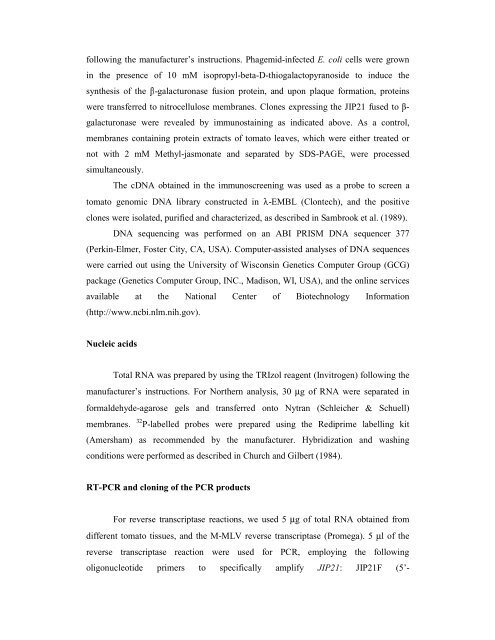Tomato CDI as a Strong Chymotrypsin Inhibitor ... - Plant Physiology
Tomato CDI as a Strong Chymotrypsin Inhibitor ... - Plant Physiology
Tomato CDI as a Strong Chymotrypsin Inhibitor ... - Plant Physiology
Create successful ePaper yourself
Turn your PDF publications into a flip-book with our unique Google optimized e-Paper software.
following the manufacturer’s instructions. Phagemid-infected E. coli cells were grown<br />
in the presence of 10 mM isopropyl-beta-D-thiogalactopyranoside to induce the<br />
synthesis of the β-galacturon<strong>as</strong>e fusion protein, and upon plaque formation, proteins<br />
were transferred to nitrocellulose membranes. Clones expressing the JIP21 fused to βgalacturon<strong>as</strong>e<br />
were revealed by immunostaining <strong>as</strong> indicated above. As a control,<br />
membranes containing protein extracts of tomato leaves, which were either treated or<br />
not with 2 mM Methyl-j<strong>as</strong>monate and separated by SDS-PAGE, were processed<br />
simultaneously.<br />
The cDNA obtained in the immunoscreening w<strong>as</strong> used <strong>as</strong> a probe to screen a<br />
tomato genomic DNA library constructed in λ-EMBL (Clontech), and the positive<br />
clones were isolated, purified and characterized, <strong>as</strong> described in Sambrook et al. (1989).<br />
DNA sequencing w<strong>as</strong> performed on an ABI PRISM DNA sequencer 377<br />
(Perkin-Elmer, Foster City, CA, USA). Computer-<strong>as</strong>sisted analyses of DNA sequences<br />
were carried out using the University of Wisconsin Genetics Computer Group (GCG)<br />
package (Genetics Computer Group, INC., Madison, WI, USA), and the online services<br />
available at the National Center of Biotechnology Information<br />
(http://www.ncbi.nlm.nih.gov).<br />
Nucleic acids<br />
Total RNA w<strong>as</strong> prepared by using the TRIzol reagent (Invitrogen) following the<br />
manufacturer’s instructions. For Northern analysis, 30 µg of RNA were separated in<br />
formaldehyde-agarose gels and transferred onto Nytran (Schleicher & Schuell)<br />
membranes. 32 P-labelled probes were prepared using the Rediprime labelling kit<br />
(Amersham) <strong>as</strong> recommended by the manufacturer. Hybridization and w<strong>as</strong>hing<br />
conditions were performed <strong>as</strong> described in Church and Gilbert (1984).<br />
RT-PCR and cloning of the PCR products<br />
For reverse transcript<strong>as</strong>e reactions, we used 5 µg of total RNA obtained from<br />
different tomato tissues, and the M-MLV reverse transcript<strong>as</strong>e (Promega). 5 µl of the<br />
reverse transcript<strong>as</strong>e reaction were used for PCR, employing the following<br />
oligonucleotide primers to specifically amplify JIP21: JIP21F (5’-

















